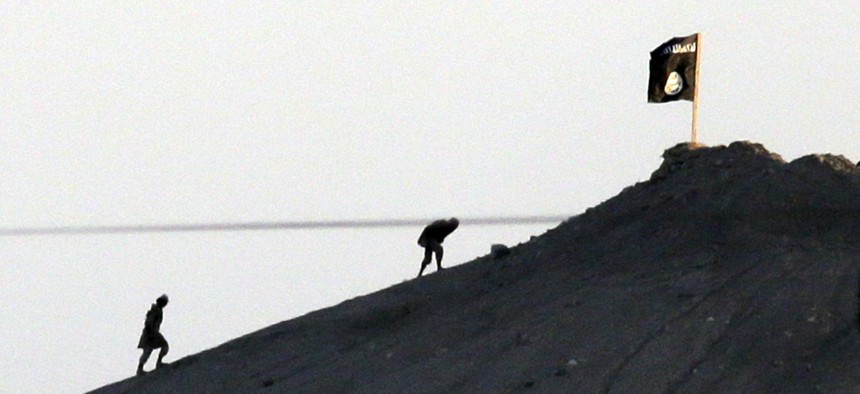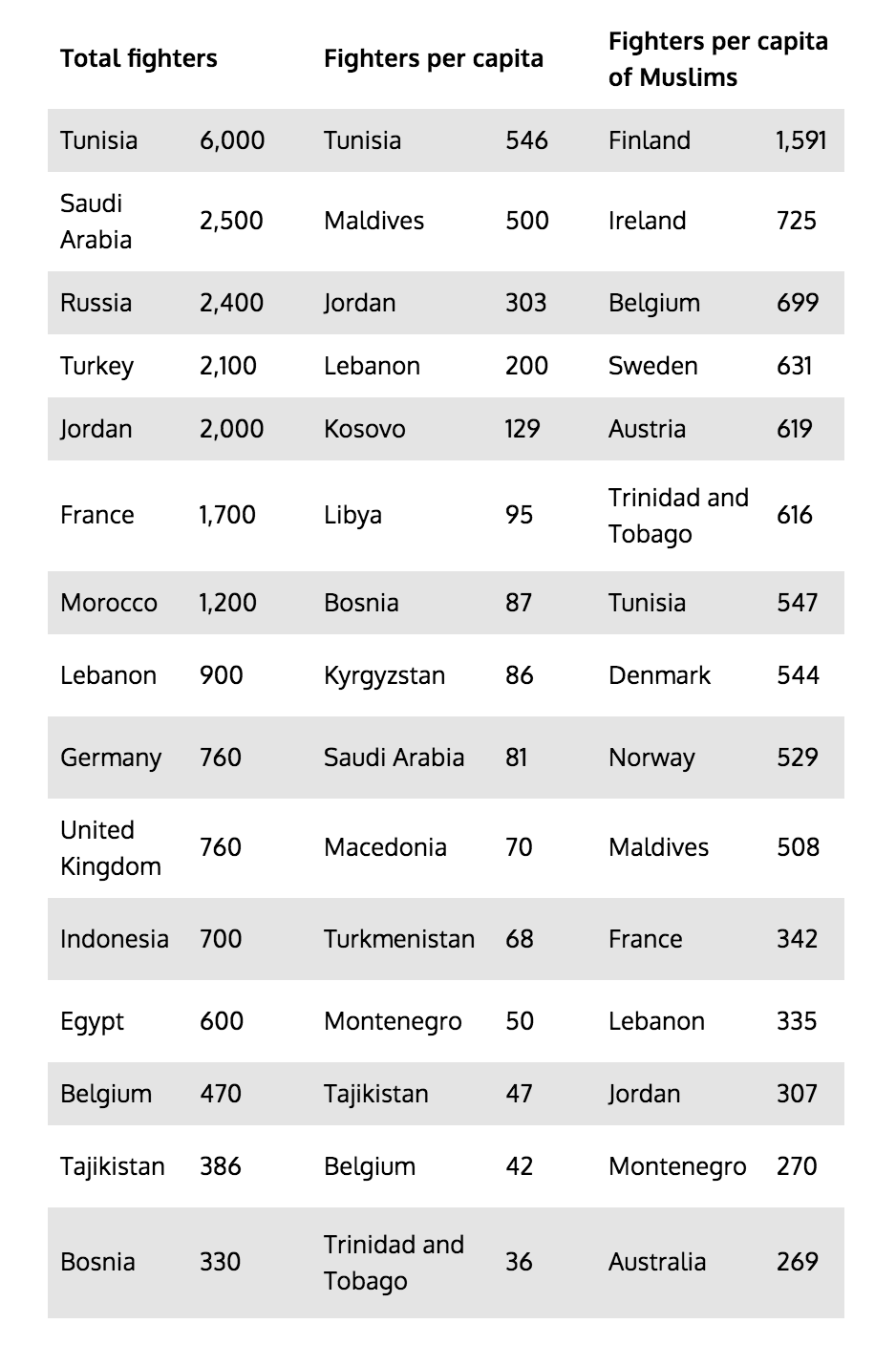
Militants with the Islamic State group are seen after placing their group's flag on a hilltop at the eastern side of the town of Kobani, Syria, Oct. 6, 2014. Lefteris Pitarakis/AP
Why So Many Foreign Fighters Flock to ISIS
A look at the factors that motivate people to leave home and join faraway wars.
Major ISIS-inspired terror attacks this summer have sent shock waves throughout the world. Europe has been hit especially hard with recent attacks, stoking fears that the continent may be especially vulnerable to foreign-trained ISIS fighters.
A recent NBER study by the economists Efraim Benmelech of Northwestern University and Esteban Klor of Hebrew University takes a close at the geography of foreign ISIS fighters, as well as the factors at work in these countries that may be serving to radicalize attackers.
The leading country for foreign ISIS fighters according to Benmelech and Klor is Tunisia, with 6,000 of them, followed by Saudi Arabia with 2,500. Russia, Turkey, Jordan, and Lebanon also rank high on the list. Three European nations, including France (1,700), Germany (760), and the U.K. (also 760) number among the top 10.

Per capita, Tunisia remains on top in terms of the number of fighters. But now smaller countries such as the Maldives, Kosovo, Bosnia, Kyrgyzstan and Macedonia number among the top ten.
Finally, the number of fighters per Muslim population shows the relative share of a nation’s Muslim population that is leaving to fight for ISIS. This list is dominated by Scandinavian and European nations. Finland tops the list, followed by Ireland, Belgium, Sweden, and Austria. Denmark and Norway also rank among the top ten along with Tunisia, the Maldives and Trinidad and Tobago.
Read more:
Inside the ISIS Enlistment Files: All Jihad is Local
See also:
Here’s What ISIS Recruits Ask Before Joining Up for Jihad
And:
A Quick Guide to the Jihadist Communications Toolkit
What factors shape these patterns? What motivates people to leave the places where they are living and join faraway wars? And what can this tell us about the process of radicalization?
The first factor that must be considered is economic hardship. Economic inequality is on the rise around the world, bringing mounting economic anxiety with it. People in countries with worse economies, fewer jobs, and greater inequality are more anxious, angrier, and may be easier to radicalize. And yet Benmelech and Klor find little evidence that adverse economic conditions play a role in the level of foreign ISIS activity or radicalization more broadly. Neither the level of inequality nor the unemployment rate appear to be related to the number of foreign fighters across nations.
In fact, it’s the richer, more developed countries that are the source of more foreign ISIS fighters. The study finds a 10 percent increase in economic output (or GDP) per capita to be associated with a 1.5 percentage point increase in the likelihood that residents of a country join ISIS. The study also finds the number of ISIS fighters to be positively correlated with a nation’s level of overall human and social development, as measured by the United Nation’s Human Development Index.
So if it’s not economics, then surely it’s politics. In that case we might expect more ISIS fighters to originate in politically repressed nations, where people lack the freedom to express their views. But Benmelech and Klor find no evidence that this is the case either. As the authors put it, “many foreign fighters originate from countries with high levels of economic development, low income inequality, and highly developed political institutions.”
If neither economic hardship nor political repression play a significant role, what is it that explains the places which create the most radicalized foreign fighters? Two things stand out, according the study. The first is the overall size of a country’s Muslim population. But the second is more interesting and much more troubling. The most important factor which explains the level of foreign fighters across nations is the extent to which ethnic and religious minorities are segregated within and unable to assimilate in the nations where they live. The study calls this “ethnic and religious fractionalization.”
The study finds a strong negative relationship between the number of foreign ISIS fighters and such ethnic and religious fractionalization across the nations.In other words, the number of foreign fighters rises in countries that are more ethnically and linguistically homogeneous, and where Middle Eastern and Muslim immigrants in particular face greater difficulties assimilating into society. As the study concludes, “the more homogeneous the host country is, the greater difficulty immigrants such as Muslims from the Middle East experience in assimilating.”
The large numbers of ISIS fighters identified by the study is bad news for Europe, where ISIS continues to recruit and train foreign fighters in significant numbers.
Worse, the effects of ethnic and religious fractionalization do not simply end with foreign fighters. Greater isolation appears to bring greater radicalization across the board, of which foreign ISIS fighters are just one extreme subset. The bigger worry is how such ethnic and religious isolation may contribute to a rise in violent extremism of all sorts, in all sorts of places.



